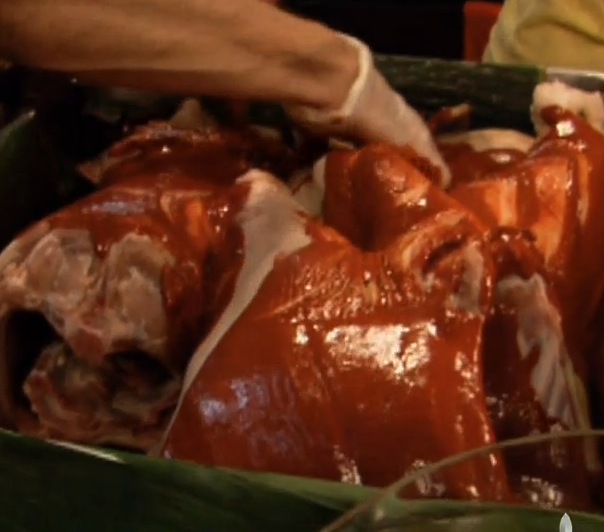
INGREDIENTS
- For the Pit
- Tape measure, stakes and string for mapping out the pit area
- Shovel (and lots of energy)
- Bricks
- A steel or corrugated metal sheet to cover the pit
- For the Pig
- 35 pound pig (you'll probably have to get yours directly from a pig farmer or an ethnic market; you can ask to have it cut into primal cuts: front quarters, legs, saddle halved down the backbone, head) OR 35 pounds of bone-in pork shoulder (Boston butt) roasts
- 5 4-ounce packages achiote seasoning (El Yucateco is a commonly found brand)
- 2 1/2 cups fresh lime juice
- 3 1-pound packages banana leaves, defrosted
- Pickled red onions, for serving (recipe below)
- Habanero salsa, for serving (recipe below)
INSTRUCTIONS
- Marinate the pig. Line your roasting pan with 2 packages of banana leaves leaving a 6-inch overhang on all the edges. Fit the pieces of pork into the bottom of the pan.Prepare the marinade by breaking the achiote bricks into pieces, dropping them into a blender jar, adding the lime juice and 1 tablespoon salt; blend until the mixture is a smooth thickish marinade. Pour the achiote mixture over the pork, spreading it evenly to coat all surfaces (I recommend you wear latex gloves, since achiote will strain your hands red).
- Cook the pig. Fold the overhanging banana leaves in over the pork, then use the last package of banana leaves to cover the pork completely. Pour about 3 quarts of water over the leaves - it will collect in the bottom of the pan and should be about 1 inch deep.Wearing heavy oven mitts, lower the pan into the very hot pit (this will take two people); the water should immediately begin boiling in the bottom of the pan. Cover the pit with the steel or corrugated metal sheet, and immediately begin piling the excavated dirt around the edges of the sheet to prevent any oxygen from entering the pit. (You have to do this carefully and completely, since any oxygen leaks will cause the fire to continue burning - which typically leads to a burnt pig. It's the intense amount of residual heat in the brick-lined pit that cooks the pig.) Once the edges are sealed, spread all leftover dirt evenly over the pit-covering sheet.Typically, a 35-pound pig needs 4 to 6 hours to cook to fall-off-the-bone tenderness.
- Serve the pig. When you've decided to take the plunge and unearth the pig, clean the dirt off the steel or corrugated sheet, then, wearing heavy oven mitts, remove it. Lift out the roasting pan full of pig and stop for a moment to savor the aroma. When you peel back the banana leaves, and press in a thermometer, the fork-tender meat should be between 150 and 165 degrees if your pit was at the right (scorching-hot) temperature.I like to carry the pan to the kitchen, remove the meat, pull meat from bone, coarsely shredding it into baking pans, and then slide all the meat, covered with foil, into a low oven, until I'm ready to serve (it will hold for an hour or two). I set the huge roasting pan on the stove over high heat (on all burners) and boil the juices until they're as rich as I like (usually I reduce them by half their original quantity). Taste and season with salt.Serve with meat on a big, deep, beautiful platter with pleanty of steaming hot corn tortillas, black beans, pickled red onions and habanero salsa.
Pickled Onions
Cebollas Curtidas
Makes 7 cups
4 large (about 1 1/2 pounds) red onions, peeled and cut in half
2 cups fresh lime juice
Salt
Thinly slice the onions (this can be done using a food processor fitted with a thin slicing blade). Scoop the onions into a heat-proof, non-reactive bowl. Pour boiling water over them, wait 10 seconds, then pour the onions into a large strainer. Return the drained onions to the bowl, pour on the lime juice and stir in the 1 1/2 teaspoons salt. Cover and place in the refrigerator until serving time. Before serving, taste and season with additional salt if you think necessary.
Habanero Salsa
Salsa de Chile Habanero
Makes about 1 cup
24 habanero chiles, stems removed
6 garlic cloves, unpeeled
1 1/2 cup fresh lime juice
Salt
Set an ungreased skillet or griddle over medium heat. Lay in the unpeeled garlic and the chiles. Roast, turning frequently, until soft and blotchy brown in spots, about 5 minutes for the chiles, 10 to 15 minutes for the garlic. Cool until handleable, then slip the skins off the garlic.
Place the garlic in a food processor. With the motor running, drop in the chiles one after another. When all are in, continue processing for about 20 seconds, then add the lime juice, 1 1/2 teaspoos salt and 1/4 cup of water. Continue processing until smooth; the habanero salsa should be the consistency of an American hot sauce.




